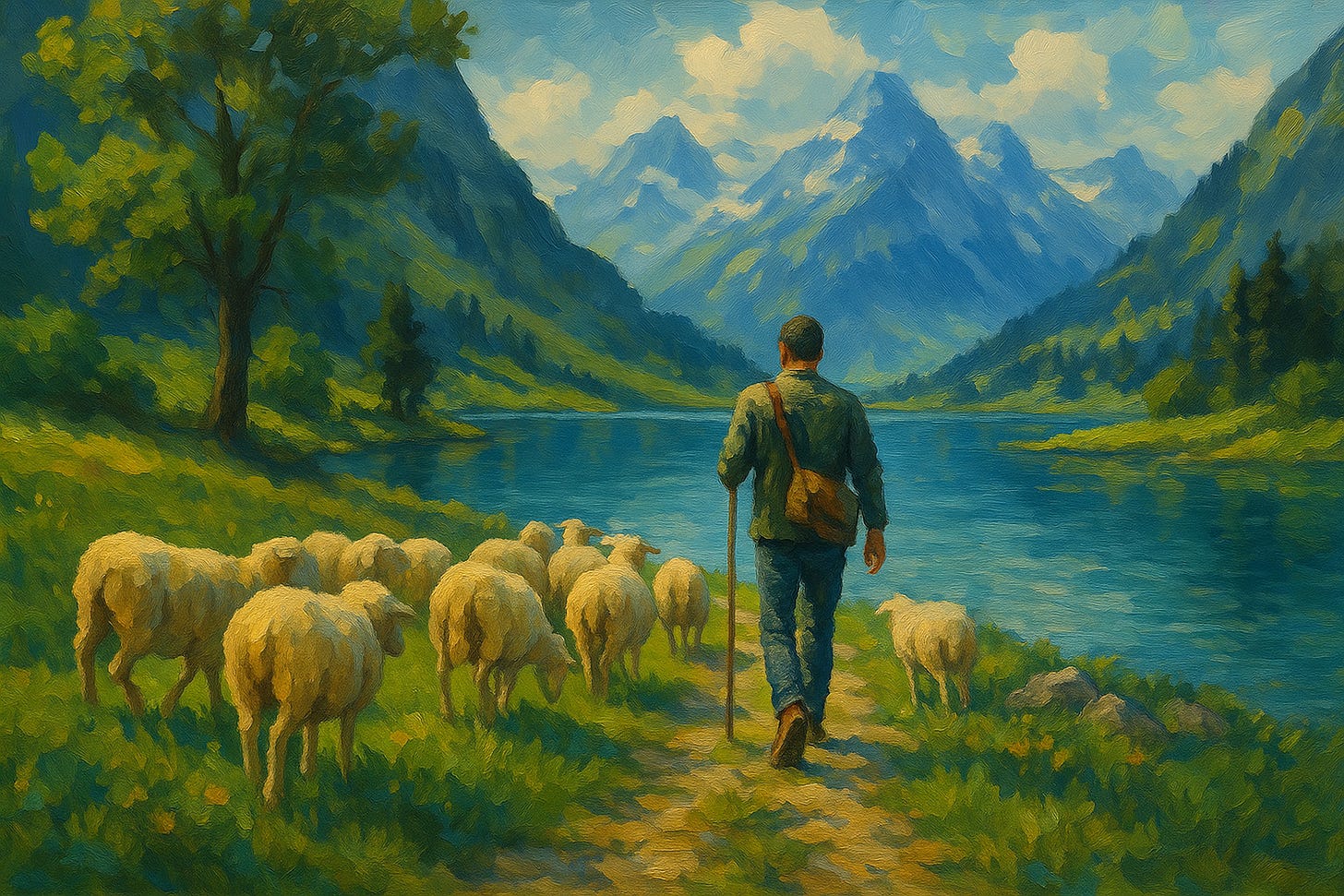The Path of Stillness - Letting the Soul be Restored
Part 2 in the Series, The Paths of Righteousness
Psalm 23:2–3 — “He makes me lie down in green pastures. He leads me beside still waters. He restores my soul.”
After awakening to the Shepherd’s presence, the soul’s next movement is surprisingly gentle: He makes me lie down.
Faith begins with trust, but trust cannot deepen until the soul learns how to be still.
Most of us try to live the spiritual life while carrying a constant interior noise - hurry, anxiety, mental clutter, a relentless sense that we must keep everything under control. Even when we believe in God, our hearts may remain restless.
Psalm 23 shows us that the Shepherd’s next act is not to give instructions, but to give rest.
Not the kind gained from vacations, distractions, or numbing habits, but the rest that comes when God quiets the inner storms and brings the soul to calm, like a sheep settling safely in its pasture.
This is the Path of Stillness: the space where God restores what the world has exhausted.
Why Stillness Must Come Before Growth
We want God to lead us in “paths of righteousness,” yet the psalm itself insists:
Restoration precedes righteousness.
Stillness precedes direction.
Before God shapes our character, He calms our soul.
Without this stillness:
prayer becomes effort instead of communion
scripture becomes information instead of nourishment
obedience becomes pressure instead of love
The soul cannot hear the Shepherd while it is flooded with noise.
Teresa of Ávila understood this deeply when she wrote:
“The soul needs time to quiet itself, so that God may speak.”
Stillness is not a technique we master.
It is a grace we receive.
The Shepherd’s Work: Feeding and Quieting
David describes two movements of the Shepherd:
1. “He makes me lie down in green pastures.”
Sheep will not lie down unless they feel safe — free from fear, hunger, and threat.
The Shepherd must address what troubles them before they can rest.
Spiritually, this means God calms our fear, softens our anxiety, and releases our sense of self-responsibility. Only then can the soul settle.
2. “He leads me beside still waters.”
Sheep will not drink from rushing, turbulent streams. They need waters of quietness.
So it is with us.
For the thirsty soul, God provides sustenance that restores rather than overwhelms - silence, beauty, unhurried scripture, prayer without pressure.
These two movements prepare the heart for the line that follows:
“He restores my soul.”
Restoration is not the result of our effort.
It is the work of the Shepherd.
What Restoration Feels Like
When God restores the soul, the change is subtle but unmistakable:
The heart softens — reactions slow, defensiveness eases.
The mind clears — anxious loops lose their grip.
Desires settle — distractions lose their power.
Trust grows — God feels near, not distant.
Restoration rarely feels dramatic.
Often it feels like breathing again - as if a weight you didn’t realize you carried has finally lifted.
This is where righteousness begins: not in willpower, but in rest.
The Discipline of Stillness: Simplicity and Solitude
Stillness is something God gives, but we must make room for it.
Two disciplines help us follow the Shepherd into this space:
1. Simplicity
Simplicity is the intentional uncluttering of life so the heart can attend to God.
It is choosing:
fewer competing voices
less busyness
thoughtful commitments
less attachment to unnecessary desires
Simplicity creates the inner spaciousness where God restores the soul.
2. Solitude
Solitude is not loneliness. It is time intentionally given to God without performance, distraction, or agenda. Even ten minutes of quiet attentiveness can become green pasture for the soul.
Together, simplicity and solitude become the practical doorway into stillness.
When Stillness Feels Uncomfortable
Many people avoid quiet because silence reveals what noise keeps hidden. Old wounds surface. Buried anxieties become visible. The heart feels exposed. This does not mean stillness is failing. It means healing has begun.
The Shepherd is gentle. He uncovers nothing to shame us — only to restore us.
If stillness feels difficult, that is not a sign to stop. It is a sign that God is deepening His work.
Moving Forward - Rested Enough to Hear
The Path of Stillness is not a pause in the spiritual life; it is preparation.
Only a restored soul can be led in righteousness.
Only a quieted heart can discern God’s voice.
Only a rested mind can recognize His presence.
Stillness is not the end of the journey.
It is where the journey becomes clear.
Closing Reflection
Imagine the Shepherd pausing the journey to tend you - not because you are weak, but because love restores before it leads.
You do not have to create peace.
You do not have to generate spiritual progress.
You only need to follow the One who leads you beside quiet waters.
Let this be your prayer this week:
“Lord, restore my soul.”
He will.
Keep reading with a 7-day free trial
Subscribe to Symbol and Silence to keep reading this post and get 7 days of free access to the full post archives.


